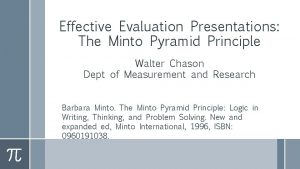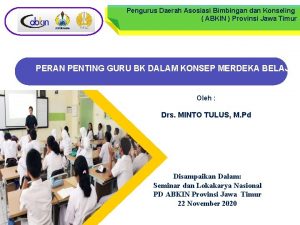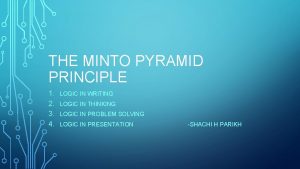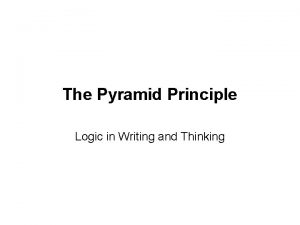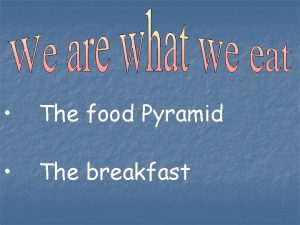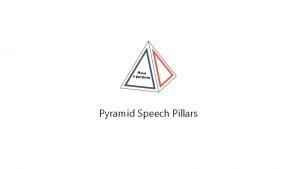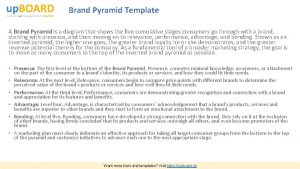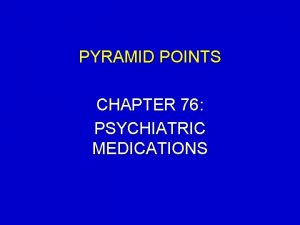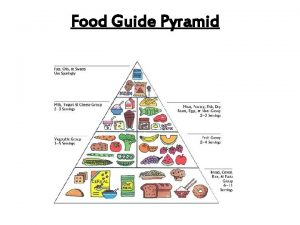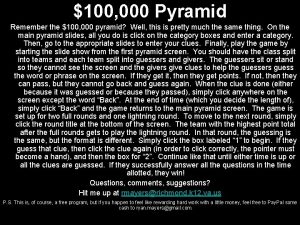The Minto Pyramid Principle An Overview June 1999

























- Slides: 25

The Minto Pyramid Principle - An Overview June 1999

“. . . There is nothing so useful as a good theory. . . ” — Kurt Lewin — 1 © XXX Consulting 1999

— Contents — n What it is? n Why a pyramid? n Major Constructs n Putting it all together n Example - Rewrite a memo to an executive n Next steps and further reading. . . 2 © XXX Consulting 1999

What is it The Minto Pyramid Principle is a technique that helps us sort through large amounts of information and communicate clearly to our audience what they need to know about a subject. The pyramid principle helps us answer such questions as: n Where do I start? n How do I know what order the points go in? n How do I organize the large amounts of data to support those points? n How do I know the specific points I should make? n How do I determine if a piece of information should be included or left out? 3 © XXX Consulting 1999

Why a pyramid? The Pyramid Principle is so effective because it reflects how the mind assimilates information. Specifically, n The mind automatically sorts information into distinctive pyramidal groupings in order to comprehend it. n Any grouping of ideas is easier to comprehend if it arrives presorted into its pyramids n This suggest that every written document should be deliberately structured to form a pyramid of ideas. 4 © XXX Consulting 1999

Major constructs The structures and the rules within the pyramid help you to not only communicate your ideas clearly, but also to discover them. The focus of the pyramid is on. . . n The narrative flow of the introduction. n The vertical relationship between points and sub-points n The horizontal relationship within a set of sub-points. n. Introduction n. Vertical Relationships n. Horizontal Relationships 5 © XXX Consulting 1999

Major Constructs - Narrative flow of the introduction Written documents will not engage the reader unless it answers a question which already exists in the readers mind. The introduction identifies that question by tracing the history of its origin: Establishes for the reader the time and place of an event Situation Complication Something occurs within the situation occurs Question That event causes a question to be raised (or would cause a question to be raised) Answer And this document serves as the answer to that question. 6 © XXX Consulting 1999

Major Constructs - Narrative flow of the introduction For example. . . n Situation: We expect productivity to be up 30% n Complication: Instead its down 10% n Question: What should we do to get back on track? n Answer: Redesign the manufacturing process. . . 7 © XXX Consulting 1999

Major Constructs - Vertical Relationship Once the introductory narrative flow is complete we establish vertical relationships of points and sub-points. Vertical relationships permit you to set up a question/answer dialogue with the reader into your reasoning. The reader will simply be forced to respond logically to your ideas. n The content of each box is an idea. n An idea may be defined as a statement that raises a question in the reader’s mind because you are telling the reader something they do not know. n The reader will then raise a logical question in his mind when they are told something the do not know namely, how and why? n You then have to provide the answers to the readers questions in the lower levels of the pyramid 8 © XXX Consulting 1999

Major Constructs - Vertical Relationships For example, the message of your document could be that we need to redesign the manufacturing process. How? Fewer Cycles Redesign the manufacturing process Easier Interfaces 9 Questions Answered Questions Asked Why? Shorter Completion Time © XXX Consulting 1999

Major Constructs - Horizontal Relationships For lower levels in the pyramid to answer questions raised by the upper levels, the lower levers must have the appropriate relationships to each other. Inductive Reasoning Deductive Reasoning Takes a set of ideas that are related simply because they can be described by the same plural noun: Presents argument in successive steps: • Reasons for • Second idea comments on the subject or predict of that statement. • Reasons Against • Third idea states the implication of those two situations existing in the world at the same time. Because Socrates is a man he is mortal • Steps • Problems • etc. French Tanks are at the Polish Border Poland is about to be invaded by tanks German Tanks are at the Polish Border • First idea makes a statement about a situation that exists in the world today. Russian Tanks are at the Polish Border All men are mortal 10 Socrates is a man Therefore Socrates is mortal © XXX Consulting 1999

Major Constructs - Summary The existence of the introductory, flow vertical and horizontal substructures help you discover the ideas in the pyramid. n Knowing the reader’s question will ensure that all the ideas you do bring together are relevant n Knowing the vertical relationships you can determine the kind of ideas you need in each grouping n Knowing the horizontal relationships you can judge that the ideas you bring together are of a like kind With this knowledge documents can be put together in writing. . 11 © XXX Consulting 1999

Context Example As an example, we will rewrite a memo written by a consultant to an executive of a large beverage company in the United States. n The beverage company is having trouble collecting payment from its customers. n He was asked if automating the company’s accounting system would increase collection time. n He answered the question by writing a memo that detailed how the new system would work. n Although the memo was full of details, it didn’t really answer the question. 12 © XXX Consulting 1999

Original Memo Example Text of original memo as written. . . To: Mr. Robert Solomon 1999 Date: June 5, From: John Jackson Below is information which detail how the collection process should be automated The primary requirement for entering billing information for a customer is that it is entered in a prescribed format. This must include the ticket number and then dollar amount of each ticket. . . The system will then produce an extract program that will be run to produce collection reports. The file will be in. PXX format. . . Upon completion, the reports will generate letter through a mail merge feature. . . 13 © XXX Consulting 1999

Analysis Example The technique forces you to draw the information that will be relevant to the reader’s question. In doing so, it allows you to deal fully with the question, rather than only partially as in the original memo. Situation Complication (7)Reasons (8) Continue question/Ans wer dialogue. (1) Automating the collection process is a good idea Question (6) NQ: Why? Answer Process invoice info accurately (4) Our collection system is inefficient (5)You want to know if automation will help. (2) Will it help? (3) Yes! Send auto reminders to customers 14 Will reduce our paper work © XXX Consulting 1999

Rewritten Memo Example Proposed text of the rewritten memo. . To: Mr. Robert Solomon Date: June 5, 1999 From: John Jackson I have spent the last two weeks looking at the feasibility of automating Big Chief’s collection system. As you are well aware, compared to industry averages Big Chief’s collection ratios are well below industry standards. You are interested in finding out whether or not automating the collection process will help Big Chief correct this situation. My preliminary investigation indicates that automating the collection process will increase efficiency in the following ways: n Will process invoice information more accurately. n Will send automatic reminders to customers. n Will reduce our paper work. 1. Processing the invoice information accurately will reduce human error. . . 2. Automatically sending customers a reminder will allow for timely payment from. . . 3. Reduction of paper work will be immediately apparent in the following departments. . . 15 © XXX Consulting 1999

Original Memo Example Text of original memo as written. . . To: Mr. Robert Solomon June 5, 1999 Date: From: John Jackson We have been requested to review the feasibility of automating the collection process for Big Chief. This process can be accomplished by Big Chief on a prepayment basis. Our primary requirement for accepting any Customer Account data from an outside source is that we receive records in a prescribed format of the ticket number and then dollar amount of each ticket. Big Chief will then produce an extract program that will be run against our liability to extract all ticket information presently on that file. The file should be in. PXX format. Upon completion, the balance will be processed through the National Accounts System. This will provide a match up by ticket number against the updated Statement file and will produce a collection letter. . . 16 © XXX Consulting 1999

Next Steps Today we were presented with the major constructs of the principle, but there is much, more. . 17 © XXX Consulting 1999

Further Reading Further exploration of this principle and its origins can be done both through XXX Consulting and your local book store n XXX Consulting Pyramid Principle Course (CBT) n Stebbing L. Susan. Thinking to Some Purpose. London: Whitefriarts Press, 1948. n Fodor, J. A. . The Language of Thought. New York: Crowell, 1966. 18 © XXX Consulting 1999

Appendix A The following slides have been taken from a real presentation given at Visteon, a Ford Motor Company division. 19 © XXX Consulting 1999

Appendix A Global Rollout of i 2 Advanced Planning Systems November 19 th, 1998 20 © XXX Consulting 1999

Appendix A - Situation Corporate Objectives n Visteon may decide to procure i 2 technologies’ suite of products on an anticipated realization of benefits. Once Visteon decides to procure i 2, the focus will turn to realizing value from this enabling technology to support Visteon’s five year plan: • Grow aftermarket sales to $1 B • Derive 20% of business from non-Ford sources • Support the Ford business at current levels … while …. • Maintaining operating expenses at current levels. 21 © XXX Consulting 1999

Appendix A - Complication The Effect of New Channel Growth Increases the Complexity of Visteon’s Supply Channel Chain Non-Ford OEM Aftermarket Super Integration Product Configurations Demand Product Sequencing Deployed Inventory Demand Lead Times Volatility Commercial Channel Complexities Product Proliferation Internet Commerce Store Specific/Mixed Pallet Global Sourcing 22 © XXX Consulting 1999

Appendix A - Question To meet Visteon’s growth and expense goals, these complexities should be addressed by introducing new business capabilities to the organization rather than ongoing financial commitments Objectives • Support aftermarket sales of $1 B • Maintain the Ford business at current levels • Derive 20% of business from non-Ford sources • Maintain operating expenses at current levels Complexities Proliferation Product Configurations Product Sequencing Deployed Inventory Demand Lead Times Volatility Internet Commerce Store Specific/Mixed Pallet Global Sourcing Response Financial More Labor (OT) Lost Sales (FR) Higher Assets (INV) Higher Capital Operating Expenses (Expedites) 23 Capabilities Retail Distribution (Direct to Store) Better Demand Forecasting Service Level Based Inventory Planning Alternative Sourcing of Demand Fast, Accurate customer commits/allocated ATP Optimized Sequencing Flexible Product/Order Configuration Multi-Site Regional Master Planning Flexible/Lean Manufacturing © XXX Consulting 1999

Appendix A - Answer I 2’s enabling technologies along with XXX Consulting’s business integration capabilities can enable Visteon to meet their five year goals Strategic Intent AC: • Support aftermarket sales of $1 B Supply Chain Strategy • Maintain the Ford business at current levels Strategy Formulation • Derive 20% of business from non-Ford sources • Maintain operating expenses at current levels Organizational Alignment Process Alignment AC: Automotive MU Supply Chain Management LOB AC: Journey Management Human Performance Enabling Technology 24 I 2 Technology Rhythm Suite SAP ERP e-Commerce Tools © XXX Consulting 1999
 Situation complication question answer
Situation complication question answer Minto tulus blog
Minto tulus blog Morley minto reforms
Morley minto reforms Mental pyramid principle
Mental pyramid principle Pyramid principle situation complication answer solution
Pyramid principle situation complication answer solution Hình ảnh bộ gõ cơ thể búng tay
Hình ảnh bộ gõ cơ thể búng tay Ng-html
Ng-html Bổ thể
Bổ thể Tỉ lệ cơ thể trẻ em
Tỉ lệ cơ thể trẻ em Voi kéo gỗ như thế nào
Voi kéo gỗ như thế nào Tư thế worms-breton
Tư thế worms-breton Alleluia hat len nguoi oi
Alleluia hat len nguoi oi Môn thể thao bắt đầu bằng từ chạy
Môn thể thao bắt đầu bằng từ chạy Thế nào là hệ số cao nhất
Thế nào là hệ số cao nhất Các châu lục và đại dương trên thế giới
Các châu lục và đại dương trên thế giới Công thức tính thế năng
Công thức tính thế năng Trời xanh đây là của chúng ta thể thơ
Trời xanh đây là của chúng ta thể thơ Mật thư tọa độ 5x5
Mật thư tọa độ 5x5 101012 bằng
101012 bằng độ dài liên kết
độ dài liên kết Các châu lục và đại dương trên thế giới
Các châu lục và đại dương trên thế giới Thể thơ truyền thống
Thể thơ truyền thống Quá trình desamine hóa có thể tạo ra
Quá trình desamine hóa có thể tạo ra Một số thể thơ truyền thống
Một số thể thơ truyền thống Cái miệng xinh xinh thế chỉ nói điều hay thôi
Cái miệng xinh xinh thế chỉ nói điều hay thôi Vẽ hình chiếu vuông góc của vật thể sau
Vẽ hình chiếu vuông góc của vật thể sau
